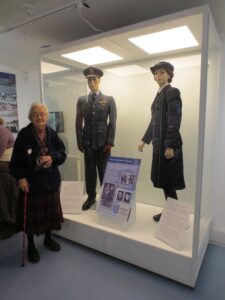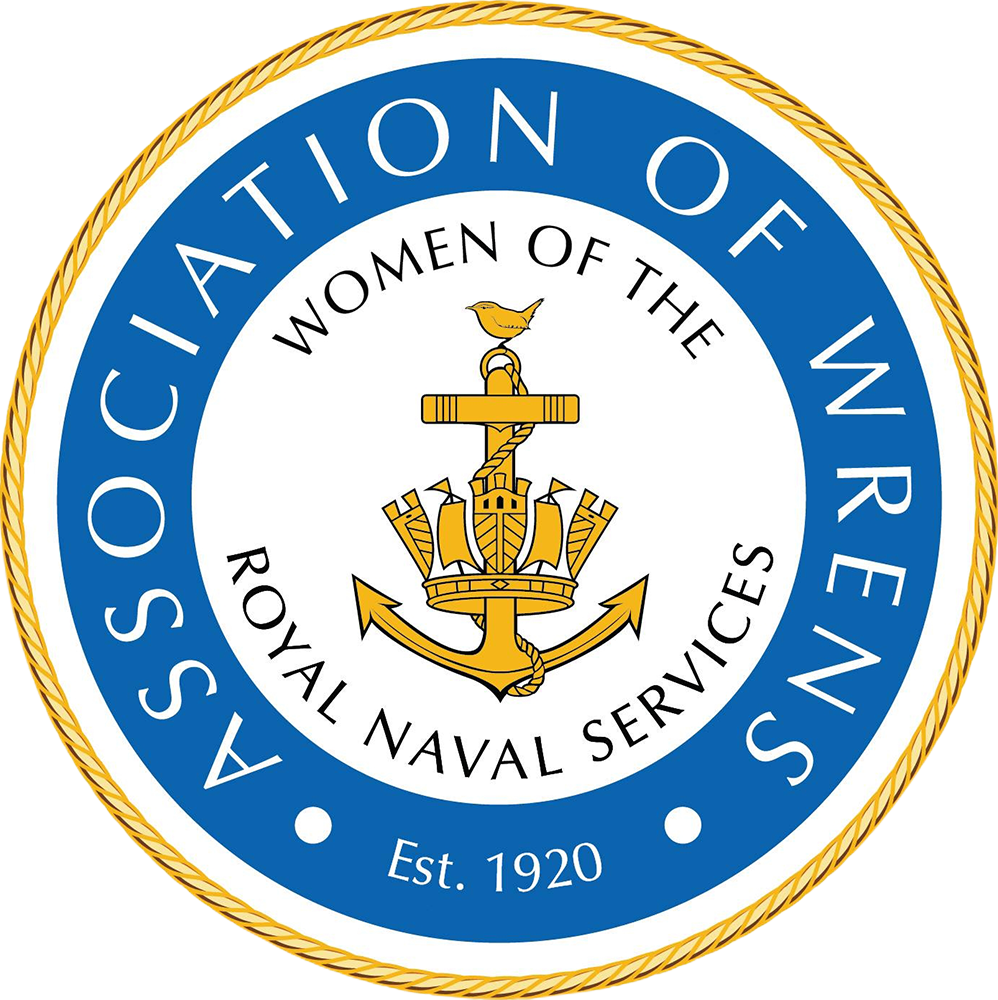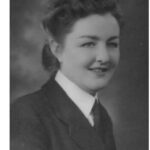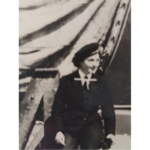Wren Pat Briggs
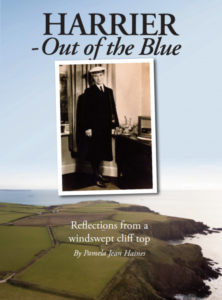
Pat was a Radar Wren from 1957 to 1962. She joined the WRNS as a bright-eyed youngster, and after her basic training in Fort Purbrook, she received her radar training in HMS HARRIER, and returned to serve there a second time in 1959 – 60. A while ago, Pat returned to Dale, Pembrokeshire, with her life-long friend, Dot Daulby, to take one of their regular trips down Memory Lane. They had met and become close friends when serving together in the late 1950’s, in HMS HARRIER, which was the Royal Naval Aircraft Direction Centre, at Kete on the Dale Peninsula.
Pat’s life in HARRIER was busy, colourful and fun-packed. She and Dot met at Kete through their shared work as Wren Radar Plotters and enjoyed a full and fulfilling life there pursuing their chosen careers. They both left Kete when it closed in 1960 and went, together, to HMS Dryad. They described how they met, “just clicked” and became close and loyal friends over the years, meeting regularly thereafter, although they lived a long way from each other. They agreed that each time they met they picked up just where they left off. Dot was Pat’s bridesmaid when she and Gordon, her beloved Naval Officer beau, were married in Portsmouth after leaving Kete, and she returned to her homeland of Wales, ending her days in Swansea in 2022.
Pat and Dot served in HARRIER between 1958 and 1960 as Wrens, on the Staff, teaching Radar Plotting to sailors before they went to sea to carry out Radar Operator roles in ships’ Operations Rooms. They also taught radar to RN Officers training to become Aircraft Direction Officers, and Meteorology Officers. Pat was prepared for her teaching role by attending a Radar course in HARRIER in 1957, which provided her with the necessary skills to run exercises and to teach and coach trainees in Radar Plotting. When Pat and Dot underwent their radar training their course comprised of ten to a dozen Wrens on an intensive course which lasted for two months. When under training they were required to march to and from their classes, but once they were on the Staff, and members of the Ship’s Company, they could just walk to work. Dot, whose home town was Swansea, brought her bicycle down, eventually, so she would be able to make the journey more quickly between the Wrens’ Quarters and the Models Rooms where they worked.
After her training at Kete, Pat was sent to Dryad in Portsmouth, but she wanted to be posted back when she learned that Gordon, her “intended”, had been posted to Kete. She would write each week to the Drafting Office in Portsmouth, and in six weeks, she was indeed posted back! HARRIER’s Chief Wren May was clearly a supportive lady, who would ask Gordon for his duties, so that she could schedule Pat to be on duty at the same time, thus affording them time off together. Gordon was a Petty Officer by then, and eventually went on to be Commissioned, and rose to the rank of Lt. Cdr. as a Gunnery Officer.
In their careers Pat and Dot worked in Dryad and Harrier carrying out their Radar teaching roles. It was no mean feat for Wrens to be teaching RN Sailors and Officers about Radar and how to use it at sea. They were often outranked, and back in the day, it was unusual for women to have such mastery of a complex technical subject that they were competent to train others – the military environment was an exception in that regard. Needs must, though, especially post World War II, when the Wrens had been recruited to fulfil such specialised roles, in HARRIER, in Radar and Meteorology. They acquitted themselves incredibly well, blazing the trail for future professional women to work in what had been traditionally male roles and needless to say, as a result, a good deal of teasing and sending-up went on, between female trainers and male trainees. They say it was all in good part!
One of Pat’s jobs was to be an Outer Wren Plotter which meant she reported the ships on the far end of the grid. Early on in HARRIER, whilst still familiarising herself with the role and developing her confidence, she was unsure of the task, and didn’t quite do as well as she should have done. The Instructor Lt. Cdr Hayes asked “Who was the outer reporter?” and just as Pat raised her hand, the lights went out, and he proceeded to chastise her roundly throughout the lights-out. When they came back on again, he said with a little twinkle in his eye “Weren’t you the lucky one?” because she had been spared the embarrassment of the faces of everyone else watching whilst she was told off!
Pat recalled how the RP Wrens would be invited to fly in the aircraft with the pilots from HMS GOLDCREST at Brawdy, for the experience of seeing what the pilots did, and hearing the HARRIER Radar Plotters directing them, over their head-sets. They were taken up in Venoms, twin tailed, twin engined jets and found the experience exciting and invaluable. Through this familiarisation they came to appreciate more clearly the vital importance of the work they were doing. Pat laughingly described how she had been warned sternly that she must not press the ejector seat button, whatever she did, so she sat with her arms folded for the whole flight!
Back at Kete, they would wait each day for the pipe to tell them whether or not the planes would be flying. If the verdict was Negative Flying, they would think “Good-ee!” as they would then have a day knitting and drinking coffee, for which they received much ribbing. They knitted sweaters – all the Wrens did – and there was a superstition that they should never knit one for their boyfriend or the relationship would finish! A superstition which was not founded for our Pat as she knitted one for Gordon, whom she eventually married.
Whilst Pat was in HARRIER, the Commanding Officer was Captain Morrow, and she also remembers Chief Wren May, Lt. Cdr. Hayes and a wonderful civilian who worked on camp, called Aloysius. Pat has a fond memory of him giving her and her husband to be, a triangular laundry basket which was surplus to requirement, and Pat still takes pleasure in using to this day!
When serving at Kete, Pat lived on the camp in the WRNS quarters. Wrens fulfilled such roles as radar plotter training, meteorology forecasting and teaching, signals, operating the telephone exchange, administrative and clerical work and stewarding and catering duties. Radar Wrens worked five days a week, from 9 until 4 and in addition they would have duties to fulfil in the Wrens’ Quarters and on the Wrens’ Gate. The Wrens’ Quarters were at the end of the camp away from the main buildings where they worked, and Wrens would have to pass the Ratings’ Quarters to reach their own Messes. The Wrens’ Gate was an additional gate which separated the Ratings’ Quarters from the Wrens’ Quarters, to which returning Wrens had to present themselves, hand in their identity card, and pick it up again when they went out. Each month the Wrens took their turn at manning the gate and they all shared the tasks within their own Messes. Pat said that when she was a bit overhung after a night out in the local pub, The Griffin, it was sometimes a struggle to find the right card to present!
Standard Military protocols were carried out as usual, at Kete, and weekly Divisions would be a part of those routines, as were rounds. Within the Mess, the Wrens had to keep their living space clean, tidy and ready for weekly rounds. They had big polishers which they used to buff up the floors and they would put newspapers down on the newly polished floors once done, before rounds, so that inspection would be a success. When walking over the newspapers, thus avoiding walking on the floor, they would spot articles which they had somehow missed when reading the newspapers earlier, so each foray across the floor yielded fresh news as they stopped to read the floor coverings!
Another aspect of life at HARRIER was the colour of the water. When running a bath they had to step into murky brown-coloured water which was clean-ish but not very inviting! There were no sink or bath plugs unless they brought their own and if they were not careful and dropped their soap it would slither away never to be seen again. The bathrooms and the Messes as a whole, were also singularly cold as the Wrennery was at the farthest-most part of the camp, close to the cliff edge, and subject to the cruelty of the Atlantic gales and the sea spray, fog and mist which would blow up on to the camp in the frequent high winds, making the Messes very cold and damp in winter. When going to bed on cold winter nights with hot water bottles and bed socks, the girls would also put their heavy greatcoats on their beds to keep themselves warm.
The Leading Wren had a cabin at the end of each Mess, to keep an eye on the ten mess-mates who lived within. Pat recalls that when she was made up to Leading Wren, she didn’t want to move out of the main Mess into the single cabin, which she felt was rather cut off and lonely but the cabins were a little more generous and private than the large shared main Mess space. If anyone wanted to contact someone in the Mess there were a couple of telephones, one at each end of the long corridor where all the Mess accommodation linked. If the phone rang, whoever was passing would feel obliged to answer and then they had to find the Wren, wherever she was, which could mean quite a trek. If she wasn’t in, they then had to go back to let the Exchange know, and replace the receiver. It was described as “Quite a palaver!”
Pat remembered with a laugh, how, on more than one occasion the male Ratings would infiltrate past the barbed wire and boundary fence, under cover of darkness, and peep through the Wrens’ Mess windows! They would shine a torch under their chins and it would give them quite a fright as they looked really ghoulish. Once discovered, the Wrens then had to attend an identity parade – which was embarrassing, to say the least – and the Ratings always got away with it as all their Messmates swore that they had been in all night!
Pat and Dot both recalled their embarrassment at having to retrieve their underwear from the mast after it had been stolen from their washing lines, hoisted up and displayed for all to see! Humour was central to life at Kete and Pat recalls how the Orders of the Day, on one occasion, described her as Leading Wren Fainter Briggs before assigning her daily duty to her. This is because she had been prone to passing out, particularly after she and Gordon had spent some late nights out on the town!
The social facilities available in HARRIER offered plenty of choice. A wonderful Cinema, Theatre productions and Sods’ Operas, Variety Shows, a wide range of Sports including cricket, tennis, deck hockey, squash and badminton, and Sports Days, Ship’s Company Dances, Scottish Country Dancings and craft activities. There was a church on the camp, with a Padre and a choir, in which Dot sang, wearing a blue Surplice. The Navy opened the base for Navy Days for the community to come in and see what went on there every summer, and all the Wrens were actively involved in participating or organising these wonderful events.
On Saturdays the Harrier Wrens would take outings on the Pussers’ Bus into Haverfordwest, which was quite the place to go. The town had two cinemas then, and Ocky Whites Department Store and the Fish and Chip shop. In those days, Haverfordwest was much smaller and less developed. At weekends, driving lessons would take place in the town, taking advantage of the many steep hills to practise gear changing and hill starts. Whilst at Kete, many Wrens, including Dot, learned to drive. The driving Instructor would come to pick them up at the HARRIER Main Gate in a Morris Minor, and they would to go Haverfordwest where their skills at hill starts and three point turns on the steep town streets would be challenged.
Pat rarely used the bus because Gordon had a car – a beautiful Zephyr Zodiac – so he and Pat would take friends into Haverfordwest as an alternative to taking the Pusser’s transport. The bus would regularly scrape or get stuck in the narrow bridge just past Dale on the way to town so Pat and Gordon and their friends were spared that excitement. They were also able to go further afield on their weekends off thanks to the car. It was a wonderful additional route to freedom.
In good weather, Pat, Gordon and Dot would visit Marloes beach during their time off and clearly it was a favourite place to go. They also participated in community activities such as potato picking at the local farms and recalled boiling some of the potatoes they had picked in the kettle in their Mess. These were two ladies who obviously believed in immersing themselves in life to the full. Pat recalls being dropped off at the Griffin after having been potato picking, and sitting outside on the sea wall, with Dot, easing their backs and spending every penny they had earned on beers! They would also call into the Griffin on runs ashore after having been out sailing.
There was no village shop in those days in Dale, but a little van would come around selling meat. Jess and Jan James, friends of Pat and Gordon, lived in the Pink Cottage on the Brig in Dale, which they knew as Artie’s Cottage, until they could be housed in married quarters. Pat and Gordon would spend weekends there sometimes, with them. Pat recalls how the boys made a very alcoholic punch one weekend, which they put into the fridge, and it turned the meat off, by the following morning. It was not just one joint of meat which had been spoiled but the meat for the forthcoming week, so it was an expensive and powerful punch!
Pat and Dot both agreed that Kete was “absolutely wonderful!” They said that it was like being on holiday when they were serving here, which aligns with the memories of so many fellow Wrens and RN personnel whose stories relate their life at Kete. Clearly it is a place which cemented many life long friendships and marriages, and Pat and Dot’s friendship bears witness to this. To this day, Pat has an eye for beautiful language and thoughtful muse. Two of the most lovely passages she has shared with me made me smile. She said “This is a lovely saying from the late Dot’s book.
A smile is a curve that sets a lot of things straight.
and she described Kete as “Lie i enaid gael llonydd” which translates as a place for the soul to find peace. Amen to that.
By Pamela Haines
